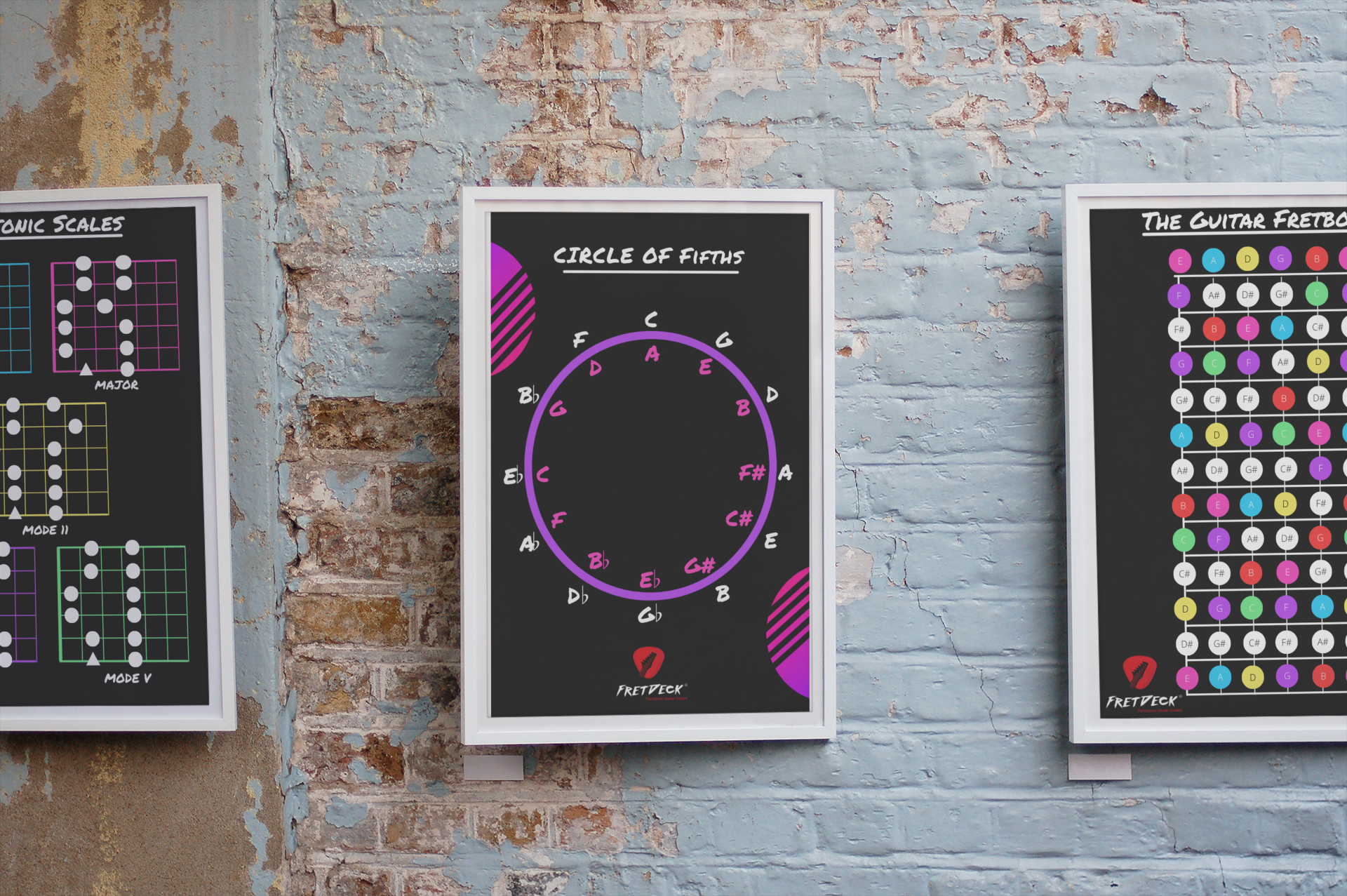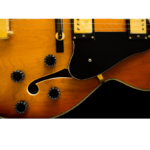When it comes to adding depth and complexity to your guitar playing, 7th guitar chords are essential tools in your musical arsenal. They enrich the harmonic structure of your compositions and provide that distinctive sound that defines various music genres, from blues to jazz to pop. In this comprehensive guide, we’ll dive into minor 7ths, major 7ths, and dominant 7ths, exploring how to use them, their roles in different chord progressions, and examples of iconic songs featuring these chords.
Understanding 7th Guitar Chords
What Are 7th Chords?
A 7th chord is a chord that includes the seventh degree of the scale, adding a layer of complexity and richness. There are three primary types of 7th chords: minor 7th, major 7th, and dominant 7th. Each type has a unique sound and serves different functions in music.

Download FREE Guitar Charts!
We have 27 FREE guitar charts to help you learn the guitar fretboard. Learn How to play chords and scales with these free resources.
Free Guitar Resources
Minor 7th Chords
A minor 7th chord consists of a root note, a minor third, a perfect fifth, and a minor seventh. It has a melancholy, introspective sound that is versatile and commonly used in various genres.
How to Play Minor 7th Chords
Let’s take A minor 7th (Am7) as an example. Here’s how you can play it:
Am7: X02010
This chord diagram shows you placing your index finger on the 1st fret of the B string and your middle finger on the 2nd fret of the D string.
Major 7th Chords
A major 7th chord consists of a root note, a major third, a perfect fifth, and a major seventh. This chord has a dreamy, jazzy quality that can add a sophisticated touch to your music.
How to Play Major 7th Chords
Here’s an example with the C major 7th (Cmaj7) chord:
Cmaj7: X32000
In this chord diagram, place your ring finger on the 3rd fret of the A string and your middle finger on the 2nd fret of the D string.
Dominant 7th Chords
A dominant 7th chord consists of a root note, a major third, a perfect fifth, and a minor seventh. It has a strong, bluesy sound that resolves nicely to the tonic chord, making it a staple in blues and jazz music.
How to Play Dominant 7th Chords
Take the G dominant 7th (G7) chord as an example:
G7: 320001
For this chord, place your middle finger on the 3rd fret of the low E string, your index finger on the 2nd fret of the A string, and your ring finger on the 1st fret of the high E string.

❌ Stop Guessing. Start Shredding.
If you’re still fumbling through scale patterns and box shapes… it’s costing you progress.
FretDeck™ is the no-fluff system that shows you exactly how to master the fretboard—fast. Early access.
⚡️ This isn’t for dabblers. It’s for players who want results.
👉 Click here to join the pre-launch now
Early access. Limited rewards. Don’t wait.
Using 7th Chords in Chord Progressions
Minor 7th Chord Progressions
Minor 7th chords create a mellow, soulful atmosphere. Here are a few common progressions using minor 7th chords:
ii-V-I Progression
The ii-V-I progression is a fundamental jazz progression that can also be used in other genres. In the key of C major, it looks like this:
Dm7 - G7 - Cmaj7
Example Song: “Autumn Leaves”
“Autumn Leaves” is a jazz standard that prominently features the ii-V-I progression. The chords in the A section are:
Am7 - D7 - Gmaj7 - Cmaj7 - F#m7b5 - B7 - EmMajor 7th Chord Progressions
Major 7th chords add a lush, open sound to progressions. Here are some common uses:
I-IV-V Progression
The I-IV-V progression is common in pop and rock music. Using major 7th chords, it can sound particularly smooth and jazzy. In the key of C major, it looks like this:
Cmaj7 - Fmaj7 - G7
Example Song: “Just the Two of Us”
“Just the Two of Us” by Grover Washington Jr. (featuring Bill Withers) is a great example of a song that uses major 7th chords to create a smooth, jazzy feel. The verse progression is:
Fmaj7 - Em7 - Am7 - Dm7 - G7
Dominant 7th Chord Progressions
Dominant 7th chords are powerful and bluesy, often used to create tension that resolves back to the tonic chord.
12-Bar Blues Progression
The 12-bar blues progression is a classic example of how dominant 7th chords are used. In the key of E, it looks like this:
E7 - A7 - E7 - E7
A7 - A7 - E7 - E7
B7 - A7 - E7 - B7
Example Song: “Sweet Home Chicago”
“Sweet Home Chicago” by Robert Johnson (and covered by many artists) is a perfect example of the 12-bar blues progression in action. The chords follow the standard 12-bar blues format with E7, A7, and B7.
Incorporating 7th Chords into Your Playing
Practical Tips for Using 7th Chords
- Voice Leading: Smooth transitions between chords can be achieved by focusing on the movement of individual notes (voices) within the chords. For example, when moving from G7 to Cmaj7, notice how the F in G7 resolves to E in Cmaj7.
- Substitution: Replace regular major or minor chords with their 7th chord counterparts to add depth. For example, instead of playing a simple C chord, try Cmaj7 for a more sophisticated sound.
- Experimentation: Don’t be afraid to experiment with different fingerings and positions. For instance, playing a Dm7 chord in different positions on the fretboard can yield interesting voicings.
Practice Exercises
- Chord Transitions: Practice transitioning between different 7th chords smoothly. For example, move from Am7 to Dm7 to G7 and back to Am7.
- Progression Practice: Take common progressions, such as the ii-V-I, and practice them in different keys. This will help you become more comfortable with 7th chords across the fretboard.
- Song Application: Learn songs that feature 7th chords prominently. Pay attention to how the chords are used and try to incorporate similar techniques into your own playing.
Iconic Songs Featuring 7th Chords
“Summertime” by George Gershwin
“Summertime” is a classic example of a song that makes extensive use of 7th chords to create a rich, jazzy feel. The chord progression includes:
Am7 - D7 - Gmaj7 - Cmaj7 - F#m7b5 - B7 - Em
“Stand by Me” by Ben E. King
“Stand by Me” features a simple yet effective use of 7th chords in its progression:
A - F#m - D - E7
“Blue Monk” by Thelonious Monk
This jazz standard showcases dominant 7th chords in a blues context. The progression includes:
Bb7 - Eb7 - Bb7 - Bb7
Eb7 - Eb7 - Bb7 - Bb7
F7 - Eb7 - Bb7 - F7
“Michelle” by The Beatles
“Michelle” uses major 7th chords to create a lush, romantic sound:
F - Fmaj7 - F7 - Bb
“Ain’t No Sunshine” by Bill Withers
“Ain’t No Sunshine” features minor 7th chords prominently, creating its soulful, melancholic vibe:
Am7 - Em7 - G - Dm7
Conclusion
7th guitar chords are powerful tools that can transform your playing, adding richness and complexity to your music. By mastering minor 7ths, major 7ths, and dominant 7ths, and understanding how to use them in various chord progressions, you’ll be well on your way to creating more dynamic and interesting music. Practice these chords in different keys, experiment with chord progressions, and study iconic songs that use 7th chords to deepen your understanding and enhance your guitar playing skills. Whether you’re a beginner or an experienced player, incorporating 7th guitar chords into your repertoire will open up new musical possibilities and take your playing to the next level.











